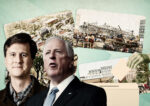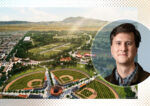The Bay Area Council has long argued that development should spring from urban infill sites near jobs and transit, not out in the suburbs. Not anymore.
The powerful, business-backed group based in San Francisco has done an about-face by backing the utopian city supported by Silicon Valley billionaires in Solano County, according to the San Francisco Chronicle, citing a new report.
The council suggests California Forever’s plan to build a city of 400,000 residents on 17,500 acres of farmland between Travis Air Force Base and the city of Rio Vista could create an integrated community with a diversified economy and affordable housing.
The Bay Area Council’s economic institute said in its report that Solano County has failed to live up to its potential.
The institute studied the county’s track record and concluded its inability to produce housing and jobs has led to a lackluster economy with long commutes, low wages and families that struggle to earn enough to keep a roof over their heads.
It also suggests that Solano County hasn’t developed jobs and housing at the same rate as similarly positioned counties across the U.S.
“Solano County finds itself in a unique and precarious position,” the report states. “The county’s geographic location adjacent to some of the most prosperous economic centers in the world should support significant population and job growth, but that growth has not been happening.”
The report comes as Fairfield-based California Forever, led by former Goldman Sachs trader Jan Sramek, works to convince voters to support a ballot measure in November that would decide the future of the unnamed city.
The ballot measure would exempt the project from the county’s “orderly growth initiative,” which requires urban development happen within the borders of the county’s seven cities, not in unincorporated areas of mostly pastures dotted with cows.
The land-use change would be needed for the master-planned development of tens of thousands of homes, businesses, a youth sports complex, parks, bike lanes, open space and a large solar farm
The project was supported by such Silicon Valley moguls as Marc Andreessen, Michael Moritz, Reid Hoffman, Patrick and John Collison and Laurene Powell Jobs. Sramek outraged locals by using Folsom-based Flannery Associates to secretly buy 66,000 acres of farmland for $800 million, then suing farmers who refused to sell.
The proposed city faces strong opposition by elected officials and environmental groups concerned about the loss of habitat, who say Sramek’s plan is a speculative money grab that’s scant on details.
Project opponents said a recent poll they conducted found that 70 percent of the people surveyed were skeptical of the utopian project. Rep. Mike Thompson, D-St. Helena, published an op-ed against the project in a local newspaper.
California Forever, meanwhile, has added local sweeteners to help sell its plan.
They include a giant youth sports complex; $500,000 in grants to local organizations; a pledge to create at least 15,000 jobs; $500 million to assist with down payments for housing, scholarships and other benefits for residents; and $200 million to revitalize the downtowns of such nearby cities as Rio Vista, Benicia and Dixon.
They also include commitments to preserve open space, create walkable neighborhoods and improve traffic flow on roads surrounding the new city.
Jeff Bellisario, executive director of the Bay Area Council Economic Institute, said the council has been studying the Northern California “mega-region” for a decade. And over the years, he said, it discussed the possibility a new city might help solve the housing affordability crisis.
The track records of previous new communities have been underwhelming, with new homes aplenty but few well-paying jobs.
But the report says the size and scale of California Forever’s proposal makes it big enough to draw employers. The group’s East Solano Plan proposes a jobs guarantee that adds 15,000 jobs where workers would earn 125 percent of the county’s average weekly wage.
“By combining housing that can bring in a diversified talent pool and a clear plan to attract employers, the East Solano Plan presents an opportunity to rethink the economy from the ground up,” the Bay Area Council report said.
Fairfield resident Duane Kromm, a leading opponent and former member of the Solano County Board of Supervisors, called the report’s conclusions “flimsy at best.” He also was skeptical about the promise of 15,000 jobs, saying employers can easily set up shop without a new city.
“They give no credence to the importance of farmland,” Kromm told the Chronicle. “The quality of life that farmland provides and what farmland does for climate change and habitat,”
— Dana Bartholomew
Read more



